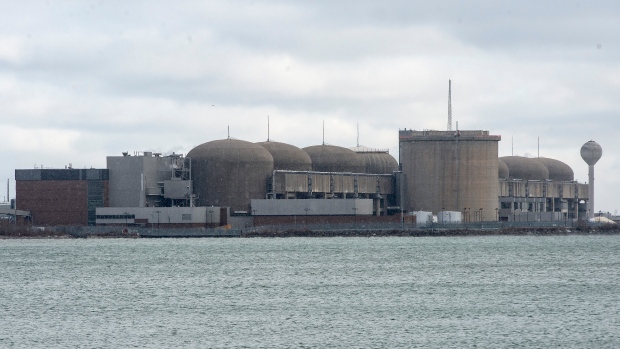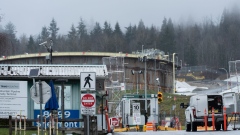Jan 13, 2020
Ontario's erroneous nuclear alert issued during training exercise, province says
, The Canadian Press

TORONTO — The unintended release of an Ontario-wide alert about an “incident” at the Pickering Nuclear Generating Station on Sunday has sparked a provincial investigation into how such an error could happen and how such future mistakes can be avoided.
The province's solicitor general said the error occurred during a routine training exercise being conducted by the Provincial Emergency Operations Centre (PEOC).
The PEOC — which is responsible for co-ordinating the provincial government's response to major emergencies — conducts exercises testing the system twice daily, but there was no intention to notify the public, Solicitor General Sylvia Jones said in an interview.
“At one of those tests this morning, instead of it going out on the test side, it went out live to the people of Ontario, and for that I sincerely apologize,” she said. “It should not have happened, which is why I have asked the chief of Emergency Management Ontario, Doug Brown, to launch a full investigation.”
She said the investigation will examine the sequence of events that led to the alert being sent out and what contingency measures should be in place. Jones said she expects the results of the probe to be made public.
“I want to delve deeper into the specifics of how it occurred, because it is very unusual,” she said.
The alert was pushed to cellphones, radios and TVs across the province at about 7:30 a.m., and Ontario Power Generation, which oversees the Pickering plant, sent out a tweet about 40 minutes after the emergency alert saying it was a mistake.
A follow-up alert was sent to cellphones nearly two hours after the original notification, and about an hour after the OPG tweet.
Jones said it took so long to send a second alert because the province felt it needed to “trust, but confirm” that there really was no impending disaster.
“There is NO active nuclear situation taking place at the Pickering Nuclear Generating Station,” the alert said. “The previous alert was issued in error. There is no danger to the public or environment. No further action is required.”
Jim Vlahos, a 44-year-old father of two in Toronto, awoke to the alert and quickly made a hotel reservation roughly 130 kilometres away in Niagara Falls. He said he figured he would go as far west as possible and then cross the border.
“Having watched 'Chernobyl' didn't help,” he said, referring to the HBO show about the 1986 nuclear disaster in the Soviet Union. “The lack of communication following the alert didn't help either,” he said.
“I have no problem leaving my phone on for these types of alerts,” Vlahos said. “But I would expect some more info from the government so I wouldn't have to overreact the way I did.”
Samantha White, 27, who grew up in Pickering but now lives in Toronto, said she has family who still live near the nuclear plant and she immediately worried for their safety when the alert woke her.
“Growing up in Pickering they prepare you for these events,” White said. “In addition to fire drills, you have nuclear safety drills where they take you in the gym, they give you fake iodine pills. So this is real, you know?”
OPG spokesman Neal Kelly said the public was never at risk and there was no radiological event at the nuclear plant, but he declined to comment on who authorized the alert.
“What I can tell you is that we're working with the province to investigate,” he said.
The original alert warned people within 10 kilometres of the facility east of Toronto of an unspecified incident, but it went to residents all across Ontario.
A similar error occurred in Hawaii two years ago when Hawaiian officials mistakenly sent out an alert warning the public about a nonexistent incoming ballistic missile at about 8 a.m. on Jan. 13, 2018 — a Saturday. The debacle triggered panic until the agency sent another message 38 minutes later notifying people it was a false alarm. State officials said the mistake occurred during a drill.
Terry Flynn, who teaches crisis communications at McMaster University, said there's a danger that this type of error will erode public trust.
“When we have continuous problems in these systems, then we have a lack of trust and people begin to ignore them. So that's the biggest fallout from this scenario.”
Ted Gruetzner, a former vice-president of communications at OPG who now works at the private-sector firm Global Public Affairs, said messages should be written in a way that clearly states it's a test.
“I'm really surprised that wasn't on there,” Gruetzner said.
In this case, the message was identified as an emergency alert from the Province of Ontario but read “there has been NO abnormal release of radioactivity from the station ... People near the Pickering Nuclear Generation Station DO NOT need to take any protective actions at this time.”
The province's auditor general highlighted issues with Ontario's emergency management in her 2017 annual report. Bonnie Lysyk found that provincial emergency management programs needed better oversight and co-ordination.
Ontario doesn't have a co-ordinated IT system for emergency management, the auditor wrote. The province tried to implement one in 2009, but discontinued the project six years later, “having spent about $7.5 million without it ever going live.”
The Pickering nuclear plant has been operating since 1971, and had been scheduled to be decommissioned this year, but the former Liberal government - and the current Progressive Conservative government - committed to keeping it open until 2024. Decommissioning is now set to start in 2028.
It operates six CANDU reactors, generates 14 per cent of Ontario's electricity and is responsible for 4,500 jobs across the region, according to OPG.
—With files from Nicole Thompson and The Associated Press






